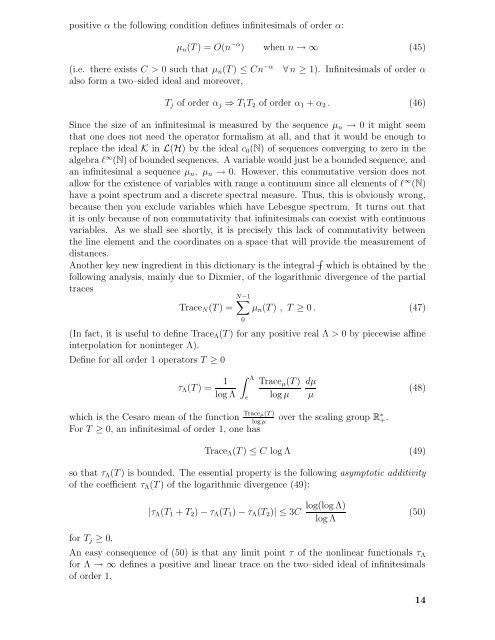Alain Connes (pdf)
Alain Connes (pdf)
Alain Connes (pdf)
You also want an ePaper? Increase the reach of your titles
YUMPU automatically turns print PDFs into web optimized ePapers that Google loves.
positive α the following condition defines infinitesimals of order α:<br />
µ n (T ) = O(n −α ) when n → ∞ (45)<br />
(i.e. there exists C > 0 such that µ n (T ) ≤ Cn −α<br />
also form a two–sided ideal and moreover,<br />
∀ n ≥ 1). Infinitesimals of order α<br />
T j of order α j ⇒ T 1 T 2 of order α 1 + α 2 . (46)<br />
Since the size of an infinitesimal is measured by the sequence µ n → 0 it might seem<br />
that one does not need the operator formalism at all, and that it would be enough to<br />
replace the ideal K in L(H) by the ideal c 0 (N) of sequences converging to zero in the<br />
algebra l ∞ (N) of bounded sequences. A variable would just be a bounded sequence, and<br />
an infinitesimal a sequence µ n , µ n → 0. However, this commutative version does not<br />
allow for the existence of variables with range a continuum since all elements of l ∞ (N)<br />
have a point spectrum and a discrete spectral measure. Thus, this is obviously wrong,<br />
because then you exclude variables which have Lebesgue spectrum. It turns out that<br />
it is only because of non commutativity that infinitesimals can coexist with continuous<br />
variables. As we shall see shortly, it is precisely this lack of commutativity between<br />
the line element and the coordinates on a space that will provide the measurement of<br />
distances.<br />
Another key new ingredient in this dictionary is the integral − ∫ which is obtained by the<br />
following analysis, mainly due to Dixmier, of the logarithmic divergence of the partial<br />
traces<br />
Trace N (T ) =<br />
N−1<br />
∑<br />
0<br />
µ n (T ) , T ≥ 0 . (47)<br />
(In fact, it is useful to define Trace Λ (T ) for any positive real Λ > 0 by piecewise affine<br />
interpolation for noninteger Λ).<br />
Define for all order 1 operators T ≥ 0<br />
τ Λ (T ) = 1<br />
log Λ<br />
∫ Λ<br />
e<br />
Trace µ (T )<br />
log µ<br />
dµ<br />
µ<br />
(48)<br />
which is the Cesaro mean of the function Traceµ(T )<br />
log µ<br />
over the scaling group R ∗ + .<br />
For T ≥ 0, an infinitesimal of order 1, one has<br />
Trace Λ (T ) ≤ C log Λ (49)<br />
so that τ Λ (T ) is bounded. The essential property is the following asymptotic additivity<br />
of the coefficient τ Λ (T ) of the logarithmic divergence (49):<br />
|τ Λ (T 1 + T 2 ) − τ Λ (T 1 ) − τ Λ (T 2 )| ≤ 3C<br />
log(log Λ)<br />
log Λ<br />
(50)<br />
for T j ≥ 0.<br />
An easy consequence of (50) is that any limit point τ of the nonlinear functionals τ Λ<br />
for Λ → ∞ defines a positive and linear trace on the two–sided ideal of infinitesimals<br />
of order 1,<br />
14

















